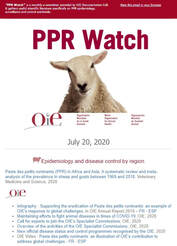|
Juan Felipe Torres-Acosta (1*), Hervé Hoste (2), Carlos Alfredo Sandoval-Castro (1), Rafael Arturo Torres-Fajardo (1), Javier Ventura-Cordero (1), Pedro Geraldo González-Pech (1), María Gabriela Mancilla-Montelongo (3), Nadia Florencia Ojeda-Robertos (4), Cintli Martínez-Ortíz-de-Montellano (5) (1) Facultad de Medicina Veterinaria y Zootecnia, Universidad Autónoma de Yucatán (UADY), Mérida, México (2) Interactions Hôtes - Agents Pathogènes (IHAP), Institut National de la Recherche Agronomique (INRA), Ecole Nationale Vétérinaire de Toulouse (ENVT), Université de Toulouse, Toulouse, Francia (3) Consejo Nacional de Ciencia y Tecnología (CONACYT), Facultad de Medicina Veterinaria y Zootecnia, Universidad Autónoma de Yucatán (UADY), Mérida, México (4) División Académica de Ciencias Agropecuarias (DACA), Universidad Juárez Autónoma de Tabasco (UJAT), Villahermosa, México (5) Facultad de Medicina Veterinaria y Zootecnia, Universidad Nacional Autónoma de México (UNAM), Ciudad de México, México  Resumen El presente trabajo profundiza los conceptos de las infecciones por nematodos gastrointestinales (NGI) en rumiantes a la luz de nuevos hallazgos de la relación animal-parásito-vegetación y muestra cómo usar estos para orientar el uso racional de los métodos de control alternativo. Primeramente, se reflexiona acerca del control de NGI en la época actual y cómo el uso indiscriminado de los antihelmínticos (AH) ha generado un gran problema de resistencia a estos medicamentos. Le investigación de NGI resistentes a AH ayudó a reconocer que las cargas elevadas de NGI se encuentran en una baja proporción de animales de cada rebaño. Esto permite plantear un nuevo paradigma de control basado en el uso selectivo de los AH solo en los animales que lo necesitan. Se propone que las bajas infecciones por NGI en los rebaños se deben a: (i) el uso de razas nativas resistentes a los NGI, (ii) la baja infectividad de las praderas durante muchos meses del año, (iii) el consumo de plantas de la vegetación nativa tropical que contienen compuestos secundarios (CS) que afectan varias fases del ciclo de NGI y, (iv) conductas de pastoreo que limitan el consumo de fases infectantes en forrajes de baja altura a las horas de mayor infectividad. Se plantea la necesidad de usar alguna estrategia de desparasitación selectiva dirigida reduciendo problemas de falsos positivos y falsos negativos comunes a varias estrategias. Para reducir la dependencia por AH convencionales se requiere de métodos alternativos que afecten las fases fuera de los hospedadores o dentro de ellos. Posiblemente muchos productores ya estén usando algún método sin ser conscientes de esto. Por ejemplo, al usar animales de razas tropicales se aprovecha su capacidad de resistir a los NGI. Además, el pastoreo en vegetación de selvas tropicales implica consumir plantas nutracéuticas que aportan nutrientes y CS con actividad AH. Las estrategias mencionadas pueden ser reforzadas con la suplementación dietética para mejorar la productividad y la respuesta inmune contra los NGI. Algunos productores podrían interesarse en la rotación de praderas, que sirve para evadir a las larvas infectantes en los potreros. En un futuro pudieran tener acceso a hongos nematófagos que pueden usarse para evitar que las larvas L3 salgan de las heces y contaminen los forrajes. Un elemento que será importante es la vacuna Barvervax® que utiliza un antígeno obtenido del intestino de Haemonchus contortus para generar anticuerpos contra este parásito logrando reducciones de cargas parasitarias > 90%. En conclusión, es necesario seguir profundizando en la relación animal-parásito-vegetación para que ese conocimiento nos lleve a tomar mejores decisiones en cuanto a los métodos de control. Todo esto para permitir la sustentabilidad de la estrategia de control de NGI en cada rebaño. Palabras clave: Era post-anthelmíntica. Métodos alternativos de control. Combinación de estrategias de control.
0 Comments
The "Art of War" against gastrointestinal nematodes in sheep and goat herds of the tropics7/31/2020 Juan Felipe Torres-Acosta (1*), Hervé Hoste (2), Carlos Alfredo Sandoval-Castro (1), Rafael Arturo Torres-Fajardo (1), Javier Ventura-Cordero (1), Pedro Geraldo González-Pech (1), María Gabriela Mancilla-Montelongo (3), Nadia Florencia Ojeda-Robertos (4), Cintli Martínez-Ortíz-de-Montellano (5) (1) Faculty of Veterinary Medicine and Zootechnics, Universidad Autónoma de Yucatán (UADY), Mérida, México (2) Interactions Hôtes - Agents Pathogènes (IHAP), Institut National de la Recherche Agronomique (INRA), Ecole Nationale Vétérinaire de Toulouse (ENVT), Université de Toulouse, Toulouse, Francia (3) Consejo Nacional de Ciencia y Tecnología (CONACYT), Faculty of Veterinary Medicine and Zootechnics, Universidad Autónoma de Yucatán (UADY), Mérida, México (4) División Académica de Ciencias Agropecuarias (DACA), Universidad Juárez Autónoma de Tabasco (UJAT), Villahermosa, México (5) Faculty of Veterinary Medicine and Zootechnics, Universidad Nacional Autónoma de México (UNAM), Ciudad de México, México  Abstract The present work delves into the concept of infections by gastrointestinal nematodes (GIN) in ruminants in the light of new findings of the animal-parasite-vegetation relationship and shows how to use these to guide the rational use of alternative control methods. First, we reflect on the control of the GIN in the current era and how the indiscriminate use of anthelmintics (AH) has generated a big problem of resistance to these drugs. The research on AH-resistant GIN helped to recognize that high GIN burdens are found in a low proportion of animals in each herd. This makes it possible to propose a new control paradigm based on the selective use of AH only in those animals that need treatment. It is proposed that low GIN infections in herds are due to: (i) the use of native GIN-resistant breeds, (ii) the low infectivity of grasslands for many months of the year, (iii) the consumption of native tropical plants containing secondary compounds (SC) affecting several stages of the GIN cycle, and (iv) grazing behaviour that limits the consumption of infective phases of GIN in low-rise fodder at hours of increased infectivity. There is a need to use a targeted selective treatment strategy aiming to reduce false positives and false negatives events commonly found in several strategies. To reduce reliance on conventional AH, alternative control methods affecting GIN phases outside or inside the host are required. Possibly many producers are already using some alternative method of control without being aware of this. For example, the use of tropical breeds takes advantage of their enhanced ability to resist GINs. In addition, browsing in the tropical forest vegetation involves consuming nutraceutical plants that provide nutrients and SC with AH activity. The aforementioned strategies can be reinforced with dietary supplementation to improve productivity and immune response against GINs. Some producers might be interested in rotational grazing, which serves to evade the infecting larvae in the pastures. In the future they may have access to nematophagous fungi that can be used to prevent L3 larvae from leaving the faeces and contaminate the fodder. One element that will be important is the Barbervax© vaccine that uses an antigen obtained from the Haemonchus contortus intestine to generate antibodies against that parasite achieving parasitic burdens reductions >90%. In conclusion, it is necessary to continue deepening the animal-parasite-vegetation relationship in order to be leaded by such knowledge to make better decisions about control methods. All this to allow the sustainability of the GIN control strategy in each herd. Keywords: Post-anthelmintic era. Alternative control methods. Combined control strategies.  Abstract Many emerging and re-emerging zoonotic infectious diseases occur in Africa. These are projected to increase as human–animal host contact increases owing to increasing environmental degradation that shrinks nature habitats for wildlife over the continent. The current outbreak of severe acute respiratory syndrome coronavirus-2 (SARS-CoV-2) responsible for causing coronavirus disease in 2019 (COVID-19) has reinvigorated discourse on the disruptiveness of the zoonotic emerging infectious diseases, owing to their transboundary character. Even as the world focuses on the COVID-19 sweeping pandemic, the Middle East respiratory syndrome coronavirus (MERS)-CoV re-emerged in Saudi Arabia infecting 18 people with five deaths; this has barely received any attention. This outbreak is particularly of concern to the pastoralists in the Horn of Africa, a region that has in recent past seen an increase in camel trade with the Gulf States, especially Yemen and Saudi Arabia. Emerging and re-emerging zoonotic infectious diseases are complex, depend on human–animal–environment interaction and pose a strain on public health systems. There is a need to address these diseases dynamically through a synergistic approach, drawing on expertise from diverse sectors. One Health approach has distinguished itself as an integrative action able to bring together multiple actors on a global, national and local scale to advance the attainment of optimal health outcomes for people, animals and the environment. One Health works by strengthening the preparedness, response, mitigation and monitoring of zoonotic infectious disease risks collaboratively. We opine that as zoonotic emerging and re-emerging infectious diseases continue to rise over pastoral Africa, comprehensive implementation of the One Health approach will be urgently required. READ MORE…  Epidemiology and disease control by region Peste des petits ruminants (PPR) in Africa and Asia: A systematic review and meta‐analysis of the prevalence in sheep and goats between 1969 and 2018, Veterinary Medicine and Science, 2020
Immunology & Vaccines, Virology & Diagnostics READ MORE… August 14-15, 2020 event will now be in-person and online  The Texas A&M AgriLife Extension Service has announced changes to the 2020 Texas Sheep and Goat Expo. The annual event, originally slated to take place at the 1st Community Federal Credit Union Spur Arena on the San Angelo Fairgrounds Aug. 14-15, will now be both at the arena and online. “With everything going on right now with COVID-19 and rules and associated recommendations continuously changing, the planning committee wanted to ensure the event could go on,” said Robert Pritz, AgriLife Extension regional program leader, San Angelo. “As of now, we plan to hold the event both online and at Spur Arena Aug. 14 and online Aug. 15.” READ MORE… Visit the Texas Sheep and Goat Expo Facebook page for updates. Registration will be available on the Texas Sheep and Goat Expo website.
A course presented by Dr. Christopher Lu in December 2019 National Taiwan University invited Professor Christopher D. Lu to offer a course entitled, “Goat and the World” at the Department of Animal Science and Technology in December 2019. Dr. Lu covered the following subjects:
Registration for Dr. Lu’s course reached full capacity within 24 hours. It was one of the largest classes in the history of the department. A sample of the comments from students who participated included:
|
IGA Blog
The International Goat Association promotes goat research and development for the benefit of humankind, to alleviate poverty, to promote prosperity and to improve the quality of life. Archives
May 2024
Categories
All
|
|
International Goat Association
2516 Millbrook Rd., Little Rock, AR72227 USA email: [email protected] -454-1641 |




 RSS Feed
RSS Feed